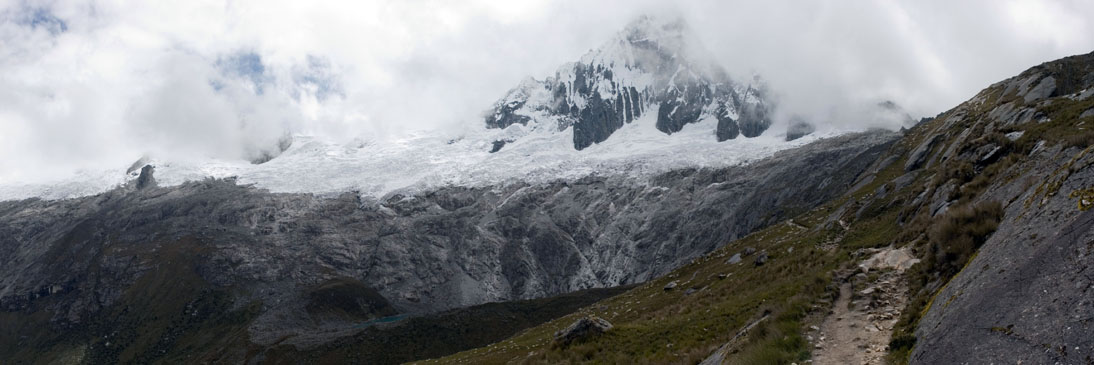Sunday, 9 April 2006
Lima, Peru
We had a gruelling seventeen hour flight with two stops, one in Amsterdam the other in Bonaire, to get to Peru. The stop in Amsterdam went quickly courtesy of the ingenious idea of putting an exhibition from the Rijksmuseum in the airport. The stop in Bonaire , by contrast, was torture. Little more than a coral atoll with some barren scrub land on top, Bonaire did not seem to have much to offer, even if they had let us out of the cafe and three duty free shops that constituted the airport. Given that it was a sunny 30°C outside it was a very cruel thing to do.
Lima was pretty much as we remembered it seven years ago. A sprawling jungle of low rise concrete buildings, traffic choked roads and colourful billboards. This time the billboards were vastly multiplied by the fact that there was a national election that day. It seemed that the main contenders were a Chavez like populist called Ollanta Humala, a woman called Lourdes Flores and a former (and by the sound of it none too good) president Alan García. Talking to our taxi driver it seemed that the choice of the Limenos was Lourdes, and the billboards for the local congressional candidates seemed to back her. On each billboard each candidate appeared to note their choice for presidential candidate and in 80% of case it was Lourdes. As was predicted by our taxi driver however, although Humala looked liked the overall favourite, he did not get enough votes to win outright so the vote went to a second vote and eventually Garcia won.
Our prepaid cab took us to Miraflores, one of the more pleasant suburbs of town where we checked into hotel El Patio. Almost seven years ago to the day we had stayed here at the end of our world tour. Little had changed in that time, it was still a charming jumble of buildings set around a courtyard overflowing with sunflowers, bougainvilleas and a host of unidentifiable tropical flowers. Although the rooms were a bit basic it was still a top place to stay in a city otherwise full of concrete.
Straight after checking in we went out to have a couple of beers and a light snack of Ceviche - raw fish marinated in lemon. Then, thoroughly jet lagged, we collapsed into bed.
Monday, 10 April 2006
Huaraz, Ancash, Peru
Our travelling was not over yet. Having seen some of Lima before we had agreed to get going to Huaraz , 420 km to the North of Lima, as quickly as possible. We woke up, skipped breakfast and caught a taxi to the bus station. This was a fairly fortunate decision as it turned out that Cruz del Sur, one of the more modern coach companies, only ran buses at 0930 and an overnight service at 2200. We managed to bag two of the last seats on the bus and had an hour to enjoy breakfast at the terminal.
Breakfast turned out to be a bit disappointing. Our memories of South American bus terminals were of completely chaotic places with millions of competing companies and many food stalls serving the waiting public. Lima, it seemed, was a bit more upmarket these days. The terminal only server Cruz del Sur and had only one, very generic, cafe in it. We settled for some empanadas and a cup of tea and waited for the bus.
The bus trip was lengthy. We had been expecting six hours but it turned into an eight our epic for no apparent reason. The initial part of the journey along the desert coast North of Lima was spectacular. In places the road was no more than a shelf hugging what seemed like 500m sand dunes with very little stopping us from plunging straight into the sea below. At a place called Patlavica we turned inland. As we climbed the desert gave way to barren mountains of rocks and mud, which in turn were replaced by stony mountains dotted with branched cacti. These finally gave way to full greenery as we climbed even higher.
The bus slowly worked its way up a stream to a 3960m pass. As we got higher the weather started taking a turn for the worse - by the time the we reached the head of the pass it was raining heavily. Over the watershed we followed another river down to Huaraz at 3052m. This river grew quickly in size and it became clear that it was in full spate at this time of the year. After about an hour of following it downhill we finally reach Huaraz. Since it was tipping down with rain we just piled into the nearest cad and went straight to our hotel.
As we were planning to stay in Huaraz for a while we had splashed out a bit on the hotel and booked a room at the Hotel Andino, one of the nicest in town. The theory had been since it was quite a way uphill from the town centre we would have a terrific view overlooking the town and a panorama of the surrounding 6000m+ mountains.
Although this eventually turned out to pay dividends, when we got to our room and went out on our balcony that afternoon all that greeted us was a panorama of rain clouds and rain. We started to get very worried, we knew that the rainy season lasts from October to April and had our fingers crossed that we were late enough in April to avoid getting a soaking on our planned trek. However that night it looked like our hopes would be dashed. We had a nice dinner of local trout in the hotel restaurant and went to bed relatively early. The rain however did not - it was still raining when I woke up courtesy of jet lag with a headache, courtesy of the altitude, at 0400.
Tuesday, 11 April 2006
Huarez, Ancash, Peru
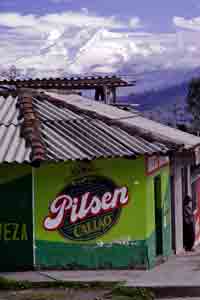
(Huarez, Ancash, Peru)
Fortunately I got to sleep again and by the time we both woke up at 0630 the rain had stopped and the cloud was clearing. We went to breakfast early and by the time we had finished it was turning into a brilliantly sunny day. We had booked a trip to see a remote archaeological site, Chavin de Huantaur. However since the bus was not due to leave until 0930 we went for a short walk around the hotel's neighbourhood.
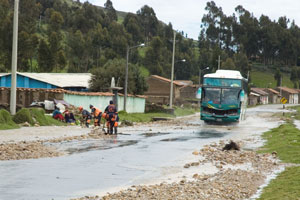
(Huarez, Ancash, Peru)
As the cloud further cleared Huascaran started to appear in the distance and the view was amazing. At 6768m, the highest mountain in Peru, the mountain was capped completely by snow and it seemed to almost glow in the sky above the town. I had a few goes at trying to take a photo but I knew it would take a dawn shot to do it justice.
When our bus finally arrived it was surprisingly full. From the number of the people in the hotel I had concluded that there were not too many tourists in Huaraz, however the bus proved me wrong as it was completely full. As soon as the bus left town our guide grabbed the microphone and started jabbering away in Spanish. We were not too bothered about understanding what he had to say, however after about an hour the near continuous babble started to get annoying.
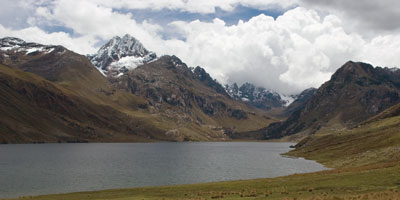
(Huarez, Ancash, Peru)
The trip to Chavin was well worth putting up with the guide for. We travelled back along the road towards the pass by which we had entered the valley, the Callejon de Huaylas. In one place the Rio Santa had completely inundated the road and they let us out to take some photos. Then we turned off the road heading east up into the mountains, We first worked our way across an immense swathe of open grassland and then started working our way up a mountain stream. After a while we got to a Lake Querococha , surrounded by black snow dusted peaks, where we were once again let out for photos.
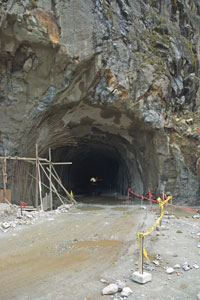
(Chavin de Huantaur, Ancash, Peru)
From the lake we climbed higher and higher until when we reached almost 4500m it looked like we could go no further as we were surrounded by steep tooth like peaks. However the road carried on and opened out to reveal the Kawish tunnel, a 400m long hole punched through the top of the Cordillera Blanca. To call it a tunnel was a bit of an overstatement. Whether it was due to the fact that it was being refurbished or had only been constructed the tunnel had an air of incompleteness about it. The archway at the front of the tunnel just looked like a cave on to which a few steel reinforcing rods had been welded. Inside it did not get any better. There was literally no road so our bus had to plough its way through huge lakes of water that had gathered in potholes along the floor of the tunnel. Construction workers with a "where do we even begin to start" look on their faces completed the scene. All in all we were pretty glad that we reached the other side in one piece.
The road down to the Callejon de Conchucos was reminiscent of being in a quarry. The terrain was steep so the road had to loop back on itself many times. As the mountainside got steeper and steeper rubble from landslides started to become more frequent, until we finally got to a place where the road was completely blocked and was in the process of being cleared by a crew with a JCB. The only thing that took our minds off it was the view. The opposite side of the valley , untouched by roads, had been neatly terraced into thousands of small fields of different shades of green. It was midday and the light was bad but I tried taking a photo nevertheless.
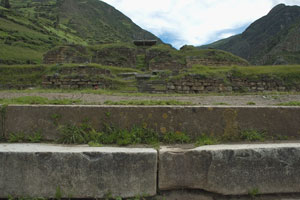
(Chavin de Huantaur, Ancash, Peru)
We finally got down to Chavin de Huantaur a good three and a half hours after starting off. The site itself was, as is often the case, overshadowed by the epic journey to get there. A smallish stone construction by the banks of a river it was not helped by the fact that it was totally overgrown giving it more of a Chavin de Bag End look. Although there was not a huge amount of exterior masonry left it would have undoubtedly looked better stripped of all its grass.
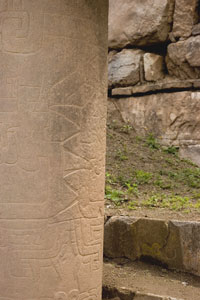
(Chavin de Huantaur, Ancash, Peru)
The Chavin Culture was one of a series of Pre-Incan cultures and dominated a large area of Peru from about 900 to 300BC. From their distinctive carvings of jaguars and other images it is apparently clear that the culture was based around totemic worship. It is also thought that ceremonies were based on the use of hallucinogens, a practice carried on to the present day by Peru's curanderos (witch doctors). It has also theorised from the large amount of jungle animals and birds in their carvings that the culture stemmed from the Amazon basin and worked its way up and over the Andes.
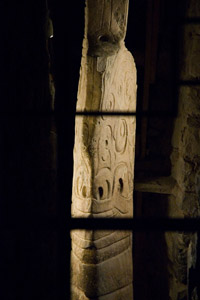
(Chavin de Huantaur, Ancash, Peru)
Chavin de Huantar was initially built in 900 BC around a small circular plaza and then extensively rebuilt around a large sunken square plaza in 400 BC. The site has been excavated and buried many times since the 19th century and of all the carvings found there over the years only the Lanzon, a 4m high totem carved in white granite remains in situ. We ditched the tour group and covered most of the site quickly finding the Lanzon by crawling down a series of passageways. It was undoubtedly the highlight of the site.
Having a bit of time on our hands we decided to head into the centre of the small modern town of Chavin. It was relatively pretty with the obligatory, sleepy central square of Plaza de Armas. We knew the tour group was due to go to a certain restaurant and so we decided to go there a bit early. It was not great as everything was deep fried. Looking at other people's meals we felt lucky that we had not ordered deep fried guinea pigs, one of the delicacies of the countryside, as it looked like a petrified dead kitten.
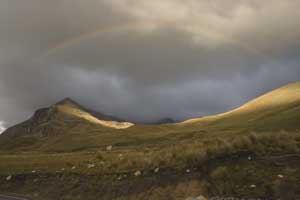
(Chavin de Huantaur, Ancash, Peru)
The journey back was not quite as epic as we knew what to expect. Back through the tunnel we encountered a few patches of rain which yielded a rainbow at one point. However it was nothing compared to the torrents of the previous day and by the time we got back to Huaraz it was completely dry. Totally exhausted by the journey we had a very filling Swiss style meal at the hotel and again collapsed into bed relatively early.
Wednesday, 12 April 2006
Huaraz, Ancash, Peru
We had a number of things to prepare for trekking so we decided to keep away from buses and just spend the day in around town. We had a leisurely breakfast then walked into town. The first stop was meant to be the Huascaran parks service office to get a permit for trekking in the national park. However when we got there we found that it has been replaced by the Ministry of Agriculture which seemed to double up as a garden centre. We asked and were told that it had moved into the centre of town so headed that way. En route we started enquiring about buses. We were due to finish our trek on Monday and had planned to go for an early bus to Trujillo on Tuesday. However asking around we swiftly came to the conclusion that the only buses to Trujillo were night buses. This was unfortunate as it would mean we would definitely spend yet another night in Huaraz. We tried asking all sorts of things, whether we could take a bus to Casina (on the coast) and change etc. But every combination met with a no. In the end we decided that rather than risk getting stuck somewhere we would take the hit and hang around Huaraz on Tuesday as well.
After a bit of messing around and running various errands such as getting kerosene for the stove and some extra provisions we stopped for lunch. Here we suffered as, just as we did the day before, we had lunch in a very Peruvian place where everything came with chips and everything was deep fried. This was no joke, I had a tortilla, basically an omelette, and even this had been coated in batter and dropped in a fryer. It seemed like the deep fat fryer was the weapon of choice in Peruvian cafes, and changing the oil was clearly something you only had to do every couple of years so consequently everything tasted of fish.
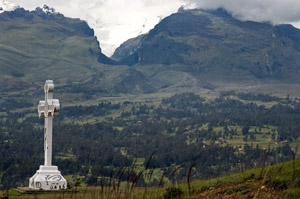
(Huaraz, Ancash, Peru)
In the afternoon we had an attempt at acclimatisation by walking up to a mirador above Huaraz, unsurprisingly one with a huge cross on it. The way up was a bit strenuous but we felt in a lot better shape than we had trying to acclimatise in Ladakh two years previously. We took a couple of short cuts and reached the top in half the time our book said. At the top we found that the cross was in desperate need of repair and a hideous concrete bunker had been constructed next to it so we did not stay for long. On the way down we found a very direct short cut which meant we got down in twenty minutes flat.
Having saved a vast amount of time on the walk we spent the rest of the afternoon preparing for our trek. This consisted of: (1) A very dramatic test of our stove where, through not remembering how it worked, I managed to have flames shooting five foot into the air (2) Stripping our kit down to the bare minimum. I was so worried about weight I decided that on top of thermals and wet weather gear I was only taking a couple of shirts and two pairs of pants - one to wear and one in reserve!! The rest of the stuff had been assembled in the UK. Finally we were going to use the freeze dried food we had bought for Ladakh, so all in all our kit could not have weighed any less.
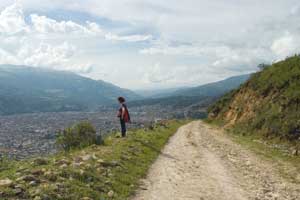
(Huaraz, Ancash, Peru)
We had tired of our hotel's kitchen so decided to go to a very pizza restaurant / bar Monte Rosa in town. The pizzas were nice and we had a much nicer and simpler meal than in the hotel. The later end of the meal was taken up by watching the spectacle of a team of Peruvians trying to erect a vertical sign on a building opposite. I have never seen anything so unsafe. They had one ladder balancing on top of a truck and then another ladder suspended from a rope from the top of the roof. On top of this second ladder a guy was perched, presumably also secured by a rope from the roof. This chap spent a while fixing a pole to the wall to hang the sign from. They then raised the huge illuminated sign up only to find that there was not enough space between the pole and the sign below to hang their sign. They ended up hanging it at an angle and then leaving. It was a complete farce since they were doing it in the evening with virtually no lighting, it was a big surprise no-one fell off.
Thursday, 13 April 2006
Llamacorral, Santa Cruz Trek, Peru
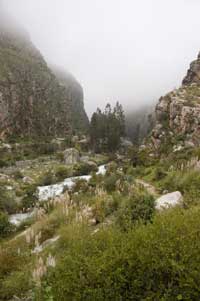
(Santa Cruz Trek, Peru)
We had to get up incredibly early, 0515, to catch a bus to Caraz . Everyone waiting at the bus station thought we were mad as generally people would catch "collectivos" i.e. mini-vans that would wait until they had collected enough people and then leave for the destination. However the hotel manager advised us that getting the straight through bus to Lima was a much faster option. Sadly this meant waiting for it to turn up at an unpredictable time so we lost any gains we may have made, however we did have the benefit of not being crammed in like sardines.
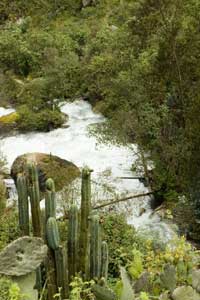
(Santa Cruz Trek, Peru)
In Caraz we bought a few things for breakfast and then finally got a collectivo for Cashapampa, the starting point for our trek. This turned out to be an exercise in maximising profit. The drivers used estate cars on account of the poor road making mini-vans out of the question and Jeeps being too expensive. However this did not stop them cramming in as many people as a minivan would take. The numbers went up and down as people went in and out of the car, however at one point I counted nine passengers, two on the front seat, five on the back suit (including two fat westerners) and two in the boot!!
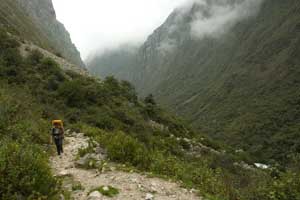
(Santa Cruz Trek, Peru)
The drive up was spectacular. As we drove away from Caraz it literally looked like we were driving towards a vertical mountain. Yet some how the car found a route up from 2400m to 2900m in the space of half an hour. To be honest it was quite a relief going up quickly. I had been rather scared of how much we had to ascend in the first day as we had descended from 3090m at Huaraz to 2400m at Caraz. So to make all this back up so quickly seemed to make being squashed in the back of a car worthwhile.
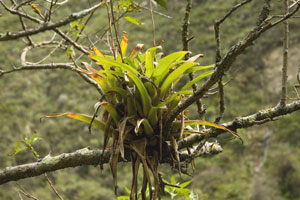
(Santa Cruz Trek, Peru)
We soon got started on our walk and within minutes were walking above the Quebrada Santa Cruz, the river which we would follow up to its watershed for the first two days of the trek. We had our breakfast by the side of the river and then set off in earnest. The first two hours of the trek were practically all uphill. The scenery of the river gorge was spectacular, cacti and bromeliads clung to the sheer rock above us. On the far side of the gorge the mountains rose hundreds of metres above us. Quite soon we started to see hummingbirds and a huge variety of different flowers and plants. Most abundant was a epithetic bromeliad which seemed to cover literally everything from rocks to trees.
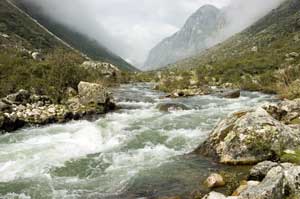
(Santa Cruz Trek, Peru)
As soon as we reached the point where, through exhaustion, we could not have physically carried on going uphill it fortunately levelled out and we found ourselves strolling (staggering) along the banks of the river for a further 4.5km. As we started to get closer to the camp site the valley widened and we started to catch glimpses of Cerro Negra up ahead, yet another jagged peak dusted with snow.
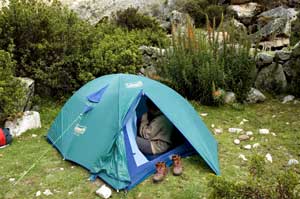
(Santa Cruz Trek, Peru)
We finally reached our camp site at Llamacorral 3712m at about 1600. We got the tent set up pretty quickly then had a well deserved meal of tea, soup and potato and beef casserole whilst getting dive bombed by curious hummingbirds that hung around in an orange flowering bush that dotted the camp site.
Friday, 14 April 2006
Taullipampa, Santa Cruz Trek, Peru
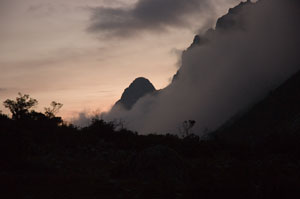
(Santa Cruz Trek, Peru)
We woke at around 0600 and I had an attempt at a few shots by the light of dawn. We had slept relatively well which meant we had acclimatised well, our camp site was at 3750m compared to Huaraz's 3090m. We had some breakfast and generally took our time getting ready, enjoying the sunshine.
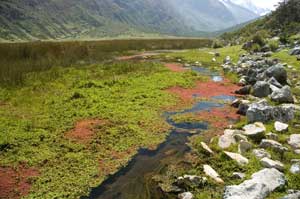
(Santa Cruz Trek, Peru)
We left around nine and walked along the Quebrada Santa Cruz until after just over an hour we reached the first of two lakes, Laguna Ichiccocha. Nestled between two peaks with water cascading down the sheer rock face above it the lake was very picturesque. It had huge beds of reeds which were a bird spotters paradise, but also some strange green and red algae which made for some interesting photographs.
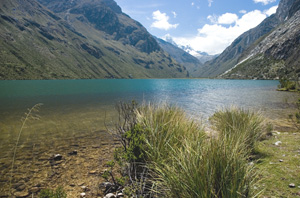
(Santa Cruz Trek, Peru)
Walking further on we came to the second lake, Laguna Jatuncocha. This was less marshy and was a deep glacial turquoise, with banks covered by red barked quinine trees. It took about three quarters of an hour to walk the length of the lake. After this we headed slightly uphill to a vast area of marshland. Here we started along a path but were shouted at by some locals 500m away. We changed course and walked towards them, when we reached them they told us that walking straight through the marsh was "mas facile". In retrospect it was rather dull however as it was just a never ending slog in a straight line, with the odd detour to avoid wet patches.
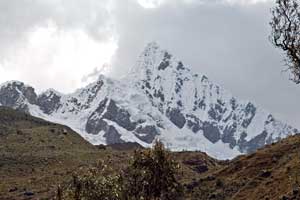
(Santa Cruz Trek, Peru)
After this we had one last uphill stretch to reach a final pampa, Taullipampa which would be our camp site for the night. On the way up we got a great view of Alpamayo, at 5947m nowhere near the highest mountain in the Cordillera Blanca. However its sharp pyramid like peak clearly makes it an attraction for mountaineers.
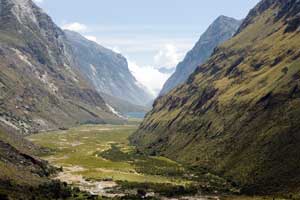
(Santa Cruz Trek, Peru)
The camp site itself was in a spectacular setting, surrounded on all sides by snow clad peaks, and between them the saddle of Punta Union - the pass we would have to climb in the morning. When we arrived it was about 1430 so although the mountains were clear of clouds the lighting conditions were harsh. Foolishly rather than just taking a few quick shots I decided to wait until sunset, This was a big mistake because a little later on the clouds settled in and we never got a clear view of the mountains again.
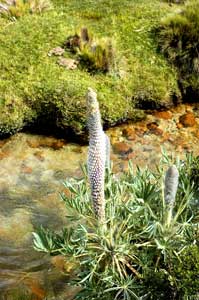
(Santa Cruz Trek, Peru)
After setting up the tent by a stream away from everyone else and filtering some water we found a spot on the opposite bank of the stream to cook our dinner. However we got half way through cooking and were interrupted by the arrival of a herd of cows from the pampa below. Although the majority of the herd made a beeline for the main group of tents one had spotted us and now stood starring at us whilst we drank our soup. In retrospect we should have chased it away but there was something very intense in the way that it starred at us taking a step forward every so often. It was pregnant and looked pretty angry. In truth it was scrounging but there is a big difference between a scrounging dog and a five foot high, one ton cow with horns. It unnerved us to the extent where we had to cross back over the river to escape it. Even then we only had half an hour before more cows found us and we had to abandon our stove outside our tent to be licked by them.
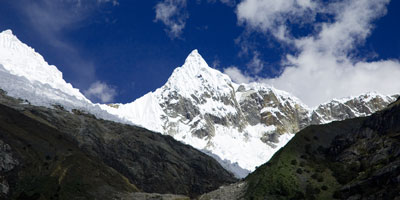
(Santa Cruz Trek, Peru)
We did not miss much of the evening as it started raining soon after however it has been a bit unpleasant. Later on in the night I had to go outside to adjust some of the tent pegs because of the wind and found it completely surrounded by four or five cows with huge saucer like eyes. It was hard to sleep after that for fear of one of them tripping up on the tent or ripping it with their horns whilst investigating.
Saturday, 15 April 2006
Paria, Santa Cruz Trek, Peru
We woke up to drizzle and this made us disinclined to rush to get going, a mistake as other groups headed up to the pass an hour before we did. We had breakfast whilst three cows and now even a scrounging donkey looked on and then packed up. It was about 0900 when we left and although we had the pass to ourselves we felt we were fighting against the clock.
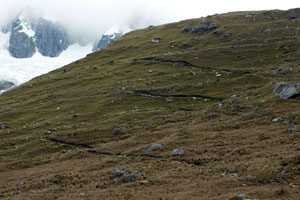
(Santa Cruz Trek, Peru)
From the camp site at 4170m it was practically 600m straight up to Punta Union at 4760m. This was not a huge ascent but when you start off at over 4000m you have to take it very slowly. About half way up it started to hail quite intensely. Hail, I conclude, is fortunately one of the least taxing forms of precipitation, it generally bounces off without getting you wet and just hangs around looks dramatic. Later on that day we would get soaked to the bone however there was no such danger with the hail so we just pushed on and made the top in 3 hours. Towards the top the weather momentarily cleared to give us some great views of the glacial Laguna Taullicocha below us.
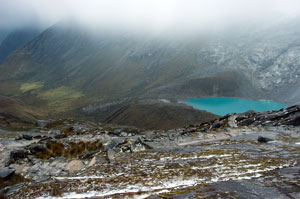
(Santa Cruz Trek, Peru)
Punta Union was a pretty odd place, an almost perfectly square corridor cut out of a rocky ridge, it would have been spectacular except for the mist that had just closed in. I could not help but compare it to the other 4700m pass we had conquered in the Himalayas. Whilst that had breathtaking 360° views and a short climb to the snow line, this looked more like something you would encounter in the lake district complete with a huddle of trekkers drinking from Thermos flasks. In fact that there was someone huddled there waiting for one of his friends to catch up. He was a South African whose equipment consisted of a pair of sandals and a plastic poncho. Although he had no rucksack and we had hauled our own gear up, we nevertheless looked a bit over equipped in comparison.
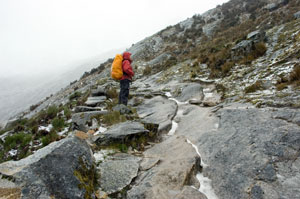
(Santa Cruz Trek, Peru)
On the other side of the pass the heavens truly let rip. There were some great views of a string of lakes below us but the descent was tough and soon gave way to an endless slog. We first had 1000m to descend which took its toll on my knees. This was not helped by having to hop from rock to rock to avoid being immersed in mud. Through the odd let up in the rain we got some amazing "Lost World" views of the valley we were descending into.
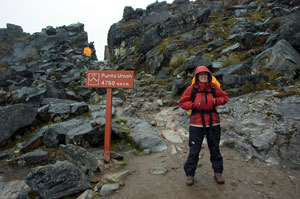
(Santa Cruz Trek, Peru)
When we finally reach the banks of the Quebrada Huari at the head of the valley the mud situation worsened exponentially. Virtually all of the next two hours was spent rock hopping and taking long detours to avoid un-traversable mud patches, The rain waxed and waned but by the time we got to the camp site at Paria at 1730 it was truly tipping it down.
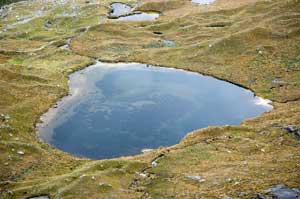
(Santa Cruz Trek, Peru)
Drenched, we put up the tent quickly then jumped straight in to shelter from the rain. This was a near fatal mistake as we had to cook outside and having dried off inside it was very tempting not to have to go back outside to boil some water. However we huddled in the tent and finally, at around 2000, there was a temporary respite in the rain and I leapt out to put the water on. It was no surprise whilst cooking that I looked around with my head torch and saw a couple of cows starring back at me. However I was too tired to do anything but shout half heartedly at them. On their part they just starred ever more longingly at my pan of boiling water.
Sunday, 16 April 2006
Huaraz, Ancash, Peru
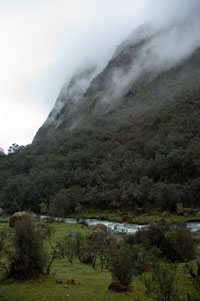
(Santa Cruz Trek, Ancash, Peru)
I had a bad night having been visited by what Devla Murphy in her book Eight Feet in the Andes, where she journeys through the Andes with her daughter and a mule, refers to as an attack of the "Squitters". Nevertheless we knew that in order to stand any chance of escaping the ceaseless rain that had set in the day before we needed to get going as soon as possible. We packed during a semi-dry spell and were off by 0715,
The walk down the Callejon de Huari was fairly pleasant. Alternating between groves of Quinea trees and huge open pampas. These were fairly marshy, at one point we saw a horse knee deep in the marsh grazing, thus again a fair degree of rock hopping was required. However it was nothing like the day before and by now we were experts on the different grades of Peruvian mud, what would hold your weight, what would give way etc. In two days of navigating our way through the maze of mud I only got a single boot immersion!
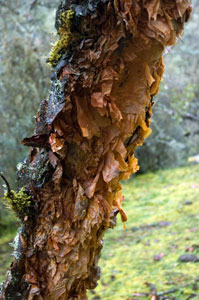
(Santa Cruz Trek, Ancash, Peru)
After a couple of hours we got to a small village called Huaripampa. This was a series of houses strung out over 2km of a mud road so offered little of interest, however it was here that we had to turn off our path for the first time in our trek. Up until Huaripampa the route had been fairly easy to follow so had not required a guide. In Huaripampa we had to find the path up to Vaqueria, where we would finish the trek. Mind you even here it was easy, everyone knew where we were going and pointed us on our way.
The walk up to Vaqueria was a hard 400m slog. When we got there it was little more than three houses and a shop, but importantly it was the only place with a road passing through it for miles around and hence the only place to catch a bus. When we got there about twenty bored locals were hanging around. As we predicted the collectivos were few and far between especially as it was an Easter Sunday. When one finally pulled in half an hour later it was going in the wrong direction and had only stopped off to drop a couple of tourists who were starting the Santa Cruz trek in the opposite direction. Fortunately Anna got talking to one of the Peruvian passengers who told us that we would stand more of a chance getting a bus if we were to take this bus to its terminus Yanama and then get a bus back past Vaqueria to Yungay (where we were heading to catch the bus to Huaraz).
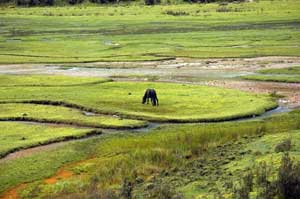
(Santa Cruz Trek, Ancash, Peru)
Things looked pretty desperate so we took this advice. Thirty bone shaking minutes later we pulled into Yanama having safely negotiated a windy mountain road with 200m drops and little to reassure us than the bus' improvised interior roll cage of scaffolding poles. The driver very kindly pointed out that his bus was not leaving for another hour so we swapped collectivos.
In retrospect we should have stuck to our guns. The other collectivo was packed with the only room on a bench which Peruvians insert behind the drivers seat facing what would normally be the first row of seats in a Toyota Hiace minivan. Even the Peruvians thought it inconceivable that three people could be stuck on this bench but that was what happened and we suffered incredibly as a result. However half an hour later when we passed Vaqueria and saw the same set of people waiting there we felt slightly better that we had taken the fastest route back to civilisation.
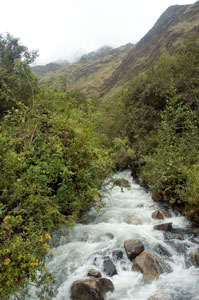
(Santa Cruz Trek, Ancash, Peru)
The journey from Vaqueriato Yungay was quite literally the most stunning and death defying journey we have ever undertaken in a bus. We had journeyed over higher passes and seen equally stunning scenery travelling the Karokoram in Pakistan. We had also experienced more danger in Ladakh where our bus had almost fallen into a ravine. However this journey combined all three elements and so surpassed everything before. The bus looped its way up one valley to 4700m then emerged into the Llanguanuco valley we were completely gob smacked. Not only were we looking out over two turquoise lakes but we were over 2km above them with an almost vertical cliff face to descend.
How and why this road existed was beyond me but in order to get down we had to wind through and endless series of switchbacks. There was no road surface, just rocks and mud, and at times turning through the tight hairpins required the bus to lurch over at alarming angles above 500m+ drops. It would have clearly taken little to close this road and indeed a team of road workers seemed to be permanently stationed there with little more than a cement mixer to construct the odd barrier to stop vehicles overshooting bends.
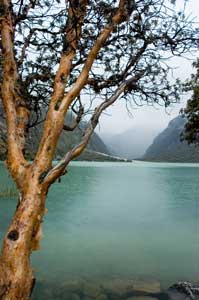
(Santa Cruz Trek, Ancash, Peru)
When we finally got to the Llangaanuco Lakes they were every bit as picturesque as the guide books make out. Luckily a couple of Peruvian tourist had persuaded the driver to stop at the lakes, much to the annoyance of the locals. With them we dashed out to take a few photos before squashing ourselves back in.
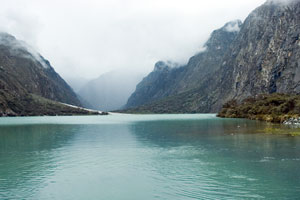
(Santa Cruz Trek, Ancash, Peru)
By the time we got to Yungay we were crippled and staggered out of the bus to call our hotel to re-arrange rooms (we had originally planned to spend an extra day trekking). We then caught a collectivo back to Huaraz, checked into the hotel, went to the centre of town to re-arrange our bus tickets to Trujillo and have dinner at Monte Rosa. By a stroke of luck the hotel had put us in one of their most luxurious rooms with a wood burning stove, satellite TV and a jacuzzi. With the use of the stove we got all our kit dry, with the use of the jacuzzi we got our legs working and with the use of the TV we were able to watch rubbish American series well into the small hours.
Monday, 17 April 2006
Huaraz, Ancash, Peru
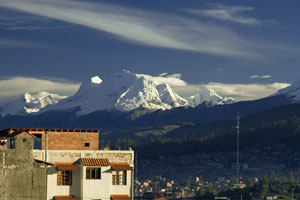
(Huaraz, Ancash, Peru)
Unfortunately, as noted before there were no day buses to Trujillo, so we spent the day get stuff even dryer and spending even more time in the bath, The afternoon we tried to consume in out and about in Huaraz but after spending a couple of hour over a leisurely lunch then going to the archaeological museum (which was a bit of a mess) we were at a bit of a loose end. Through a combination of more eating and a bit of reading we finally made it through to 2130 when the bus left.
Tuesday, 18 April 2006
Trujillo, La Libertad, Peru
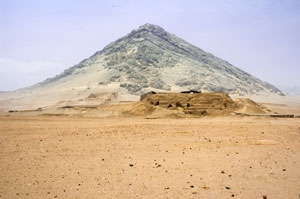
(Huaca de la Luna, La Libertad, Peru)
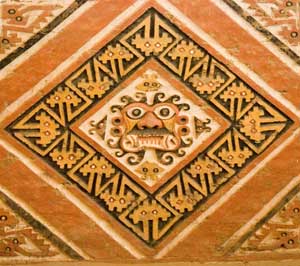
(Huaca de la Luna, La Libertad, Peru)
We had a fitful sleep on the bus. It has been advertised as a "semi cama" which seemed to indicate that you spent the night half awake. We fully woke just as we were getting into Trujillo and were passing a massive pile up where a lorry has ploughed into the side of a coach. Fortunately on-one had been injured but it looked rather surreal as the luggage compartment had been ripped open and luggage was strewn all over the road.
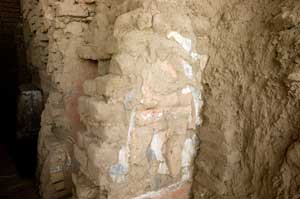
(Huaca de la Luna, La Libertad, Peru)
From the bus station we got a taxi to our hotel, The Libertador a beautiful colonial mansion of the Plaza Major of Trujillo. It had been completely gutted and refitted inside. We had a sleep in our room and then went for a late breakfast before heading out to see the Huaca del Sol and Huaca de la Luna, two temples to the south of the city. We took a collectivo out to them, an interesting experience as being in competition with the public buses they had to actively gather passengers from the street often pulling up by the curbside and asking people where they were going.
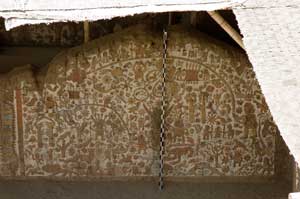
(Huaca de la Luna, La Libertad, Peru)
The Huaca de la Luna and the neighbouring Huaca del Sol were constructed by the Moche culture which was at its peak between 400 AD and 600 AD. As it rains very infrequently on Peru's coastal plain the Moche survived from fishing and from a handful of rivers that bring rain and glacial melt water down from the Andes. They also built vast temple complexes from adobe (mud bricks) where there is evidence that they practised human sacrifice in order to placate their rain gods.
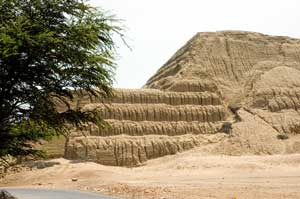
(Huaca del Sol, La Libertad, Peru)
Although rain is infrequent El Nino events generally result in rainfall every decade and, even more rarely, severe flooding. The effects of this erosion can be seen on the unexcavated Huaca del Sol. However luckily the Moche had the tradition of rebuilding their temples every generation and did so by adding a new layer over the top of the old one. Thus although the last layer of building has been destroyed, by peeling back the layers archaeologists have been able to reveal amazing painted bas relief of the earlier layers.
One annoying feature of the temples is that they lumber you with a guide presumably in some sort of communistic job creation scheme. Our guide was a young woman who was barely able to speak English, and she was ecstatic about Anna being Greek. She felt that the Greek mythology was the root of all mythology and could be used to explain a lot of the figures depicted around the temple. However she was able to point out a few things that we would have missed had we been by ourselves and was at the very least enthusiastic.
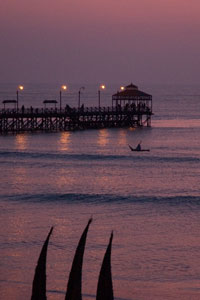
(Huanchaco, La Libertad, Peru)
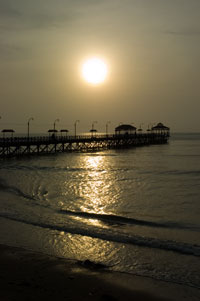
(Huanchaco, La Libertad, Peru)
After visiting the Huacas we had some lunch then set out to find a collectivo for Huanchaco , a fishing village a few kilometres from Trujillo. The village is noted for its fishermen who use Caballitos del Mar, unique one man boats made from bundles of reeds. The design of the boats dates back to Pre-Incan civilisations like the Moche. Huanchaco was also meant to be an up and coming beach resort with several good fish restaurants.
It was probably a bit late in the season as a lot of the restaurants were empty however we had a very atmospheric walk along the coast and had a nice dinner of Cerviche and beer whilst watching the sun set. After dinner we returned to Trujillo where we had some dessert at a very traditional pastelleria then went to sleep.
Wednesday, 19 April 2006
Trujillo, La Libertad, Peru
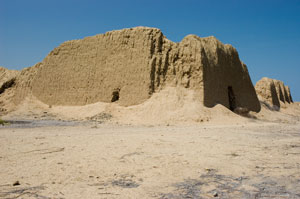
(Chan Chan, La Libertad, Peru)
We had set aside the day to go to visit Trujillo's other well known ruins that of Chan Chan , a vast city complex built from adobe by the Chimu empire. The Chimu lived around 1100ad and were noted for their very elaborately planned and geometric city complexes. They immediately pre-dated the Incas and are one of the cultures that was subsumed into the Inca empire. The city was conquered by the Inca Tupac Yupanqui in the 1470s who cut off the aqueduct supplying water to the city upon which the city elders, fearing that they would lose the impending battle, surrendered to the Incas. The Incas were skilled at integrating other cultures into their own and immediately took the Chimu rulers and goldsmiths to Cusco and ran Chan Chan themselves. Sixty years after it was conquered the Spanish arrived to find a ghost town. The Incas were embroiled in the bitter civil war which set the scene for their defeat by the Spaniards and had abandoned Chan Chan.
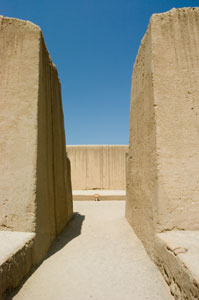
(Chan Chan, La Libertad, Peru)
Getting to Chan Chan, which was out in the desert just north of Trujillo was relatively easy. We got the same collectivo we had taken to Huanchaco the night before, got off half way then walked through the desert for a couple of kilometres. The complex itself was spread out over kilometres of desert, some of it little more than faint impressions of walls, other parts vast crumbling ramparts.
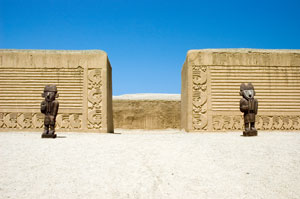
(Chan Chan, La Libertad, Peru)
The main temple complex, the Tschudi, had been partially restored and walking inside it was hard not to be impressed by the scale. The first area you enter is a huge square ceremonial courtyard whose walls were decorated with a pattern of cockerels and parallel lines. The lines served to amplify the scale of the courtyard by drawing the eye along them. Following this you enter the "Corridor of the fish and the birds" Again decorated with a geometrical pattern the corridor leads to an area of chambers that apparently served various ceremonial purposes.
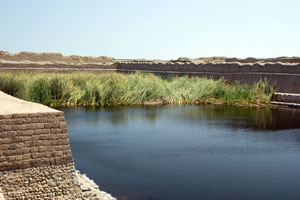
(Chan Chan, La Libertad, Peru)
After that we got to a huge ceremonial tank, filled from an underground water source it was literally an oasis in the middle of the desert. Reeds had grown in the tank and birds and dragonflies darted around it. Finally at the back of the complex at the far end of the complex was a vast geometrically arranged burial area, with a central pit for the royalty and smaller satellite pits around it for servants etc. We had a look round then headed back out to the site's shop to cool off.
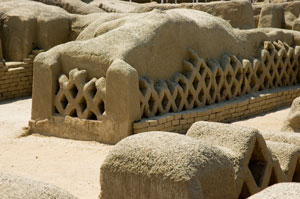
(Chan Chan, La Libertad, Peru)
As well as Chan Chan there are a number of other partially preserved Chimu Huacas around Trujillo and we had decided to head next to Huaca Arco Iris. We decided to get a taxi there from Chan Chan to save the time walking back through the desert and having to hail a collectivo then change to a second collectivo. However we had a bit of a problem, we had no small change on us. Around the world we had experienced the problem of people not being able to change larger denomination notes. Peru, however, is the only place where you can be 100% sure that no-one carries change. Even paying for something that costs 1 soles (about 20 pence) with a 10 soles note will get you evil stares as the shop keeper is forced to beg neighbouring shops and passers by to gather change.
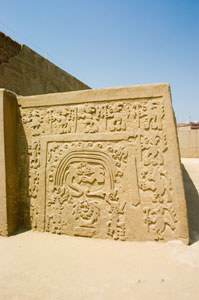
(Trujillo, La Libertad, Peru)
So as you can imagine when we attempted to pay for the 10 soles taxi journey with a 100 soles note (a very large denominated in Peruvian terms as it is equivalent to around £20) we were doomed. The driver looked at us as if we were crazy, then waved it to another taxi driver, who exclaimed "puta" before rapidly driving off. In the end we literally had to give him all of our coins and change to meeting him somewhere in the middle, keeping aside a small amount to get back into town.
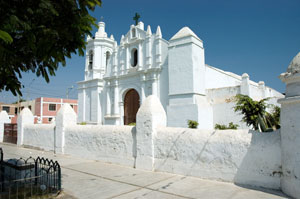
(Trujillo, La Libertad, Peru)
Both Huaca del Arco Iris and Huaca Esmerelda (which we visited next) were much smaller than Chan Chan but were well decorated with bas reliefs depicting various deities and geometric patterns. Getting back into town was a trial however, we got on a collectivo which we thought was the correct route, however we realised too late that it was not and had to get off in the middle of nowhere. Bad tempered we walked around trying to get change for our 100 soles note, to no avail. In the end we found a taxi driver who was prepared to try a bit harder to break our bank note by going to a garage. But unbelievably the garage had no change either, in the end we had to get him to take us back to our hotel and have them bail us out!!
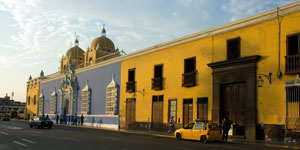
(Trujillo, La Libertad, Peru)
After the trials of getting home we had a quick siesta then took some photos in and around Trujillo's colourful colonial centre. Finally we had a papa rellena and a beer at an interesting little bar and had some pizza at a nice Italian restaurant around the corner from our hotel.
Thursday, 20 April 2006
Trujillo, La Libertad, Peru
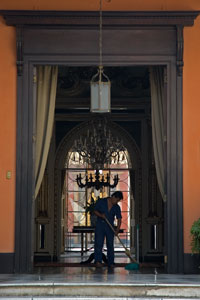
(Trujillo, La Libertad, Peru)
We had decided to leave Trujillo on the 1300 bus to Lima so had the morning to potter around the town. Our first stop was the Palacio Iturregui, a mansion built by a general and now used by Trujillo's Central Club, It is built around three courtyards to a very classical design, the rooms surrounding the courtyards serving many different functions. We found a private dining room, a library and even a snooker room.
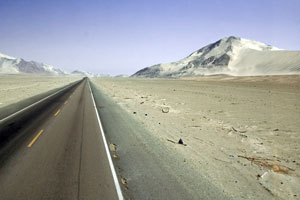
(Trujillo, La Libertad, Peru)
After this we went to visit the Convent of el Carmen, home to a closed order of eleven nuns. This provided a very Pythonesque experience as when we went to the entrance we were faced with a revolving wooden drum with a spy hole in it. We were asked what we wanted by a disembodied voice behind the hatch and then were asked to put six soles in a compartment in the drum, upon which it rotated and our money disappeared into the gloom. We then turned around and were surprised to find a man behind us who proceeded to show us around the public areas of Convent. He showed us the chapel, just to the right of which was a chamber, screened off by an iron portcullis covered by spikes, in which the nuns would go to participate in services. We were also shown the convent's collection of religious paintings, some of which dated back to the seventeenth century.
After this we jumped on the bus back to Lima, an eight hour journey along endless desert roads. We watched a few films on the bus, read a bit and somehow used up the time. When we got to Lima it was late and we just checked into our hotel then went to sleep.
Friday, 21 April 2006
Lima, Peru
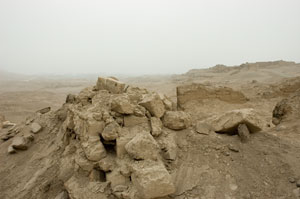
(Pachacamac, Lima, Peru)
Since we had seen quite a few ruins of pre-Incan civilisations we decided to try and see at least one Incan one, and had opted for Pachacamac 30km to the south of Lima. Although the temple complex at Pachacamac was one of the Inca centres of worship it shows signs of development from 500 AD onwards. Pre-Incan civilisation worshipped at its temples and it is probable that the Incas, who relied heavily on the traditions of former civilisations, integrated the temple and the beliefs it encompassed into their own culture.
Although little more than a jumble of mud walls the temple was very atmospheric because there were very few people there and a coastal mist had set in and was swirling around what little was left. We walked around and also had a look at the Convent of the Sun Virgin which was undergoing extensive restoration.
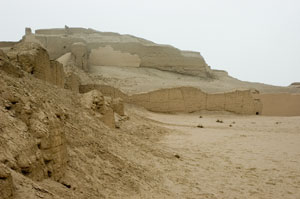
(Pachacamac, Lima, Peru)
After Pachacamac we had intended to visit the Lomas de Lucumo, one of the unique coastal environments of Peru where low hills in the desert catch incoming coastal fog and so support a very unusual ecosystem. However our first issue was that the taxi driver we had hired for the morning seemed very unsure of where exactly we wanted to go, let alone why we wanted to go there. He asked around and eventually we found the entrance to the Lucomo national park in a very dusty and surprised little town. There was no-one around but an information board told us that we were there in the wrong season. Since wandering around in the hills with little hope of finding any flowers, and quite a large possibility of getting mugged, we decided to head back into town.
We got the driver to drop us off at the National Archaeology museum in the suburb of Pueblo Libre. Here we were able to consolidate a lot of what we had seen at various sites around Peru. A lot of the finds from Chavin de Huantaur were there along with a variety of other artefacts from different cultures. The museum was not desperately well presented but we had seen worse. After this we went back to our hotel, cleaned up, and went for a really nice dinner at Las Brujas de Cachiche, a top notch restaurant with a lot of experimental dishes offering twists on pre-Columbian recipes from over a 1000 years ago. They also had a trendy bar which we retired to after dinner.
Saturday, 22 April 2006
Lima, Peru
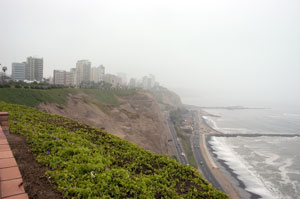
(Lima, Peru)
Sadly it was our last day. We went for an early morning walk along the cliffs at Miraflores. After this we went for one last long lunch of Ceviche at an excellent sea food restaurant in Miraflores and then went back to our hotel to catch a cab back to the airport. As one last parting taste of South America, our taxi driver was a pretty amazing character with a battered old Cadillac who had an amazing collection of tapes of Cuban music which he played for us all the way to the airport.








